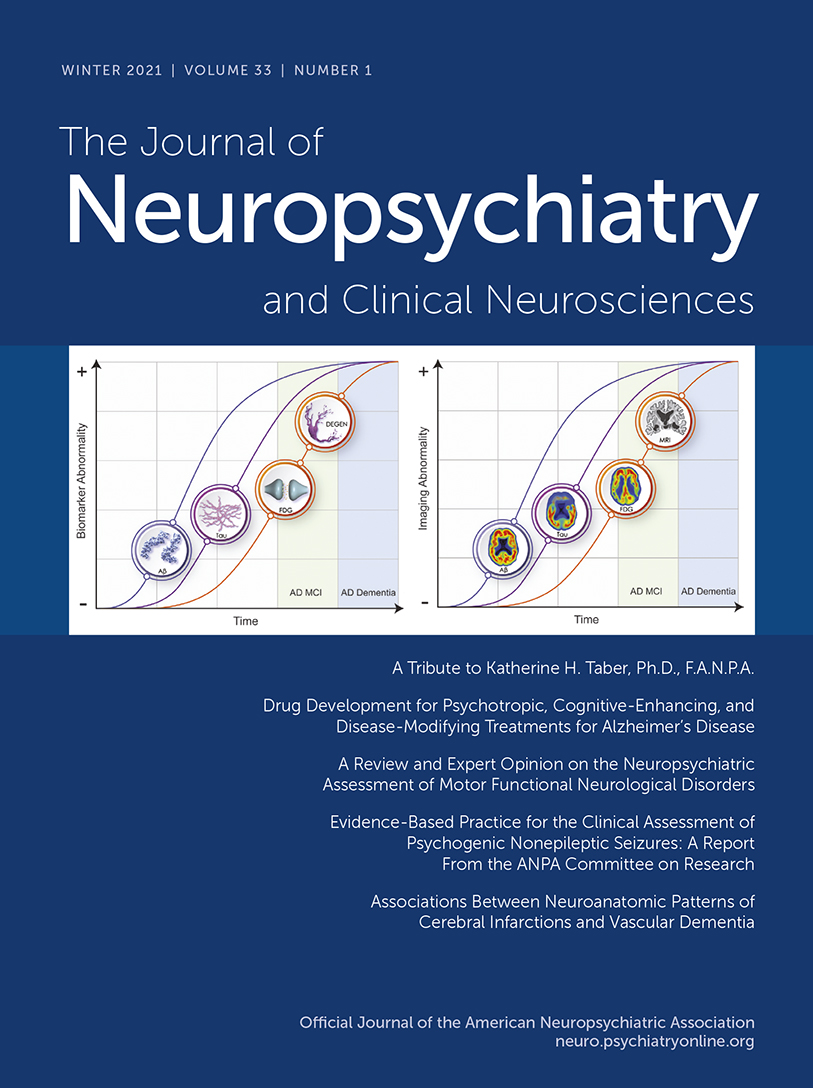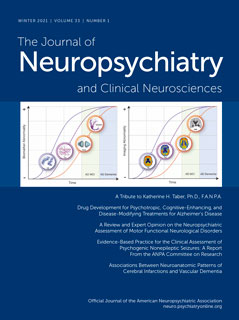Details
Department of Psychiatry, Tokai University School of Medicine, Isehara, Kanagawa, Japan (Mikami, Sudo, Kimoto, Yamamoto, Matsumoto); Teikyo Heisei University Graduate School of Clinical Psychology, Tokyo (Sudo); Department of Clinical Pharmacology, Tokai University School of Medicine, Isehara, Kanagawa, Japan (Orihashi); Department of Neurology, Tokai University School of Medicine, Isehara, Kanagawa, Japan (Mizuma, Uesugi, Kawamura, Honma, Nagata, Takizawa); Department of Neurology, Seirei Hamamatsu General Hospital, Hamamatsu, Shizuoka, Japan (Honma), and Department of Psychiatry, Carver College of Medicine, University of Iowa, Iowa City (Robinson).
Takeshi Sudo, Ph.D.
Department of Psychiatry, Tokai University School of Medicine, Isehara, Kanagawa, Japan (Mikami, Sudo, Kimoto, Yamamoto, Matsumoto); Teikyo Heisei University Graduate School of Clinical Psychology, Tokyo (Sudo); Department of Clinical Pharmacology, Tokai University School of Medicine, Isehara, Kanagawa, Japan (Orihashi); Department of Neurology, Tokai University School of Medicine, Isehara, Kanagawa, Japan (Mizuma, Uesugi, Kawamura, Honma, Nagata, Takizawa); Department of Neurology, Seirei Hamamatsu General Hospital, Hamamatsu, Shizuoka, Japan (Honma), and Department of Psychiatry, Carver College of Medicine, University of Iowa, Iowa City (Robinson).
Yasushi Orihashi, M.S.
Department of Psychiatry, Tokai University School of Medicine, Isehara, Kanagawa, Japan (Mikami, Sudo, Kimoto, Yamamoto, Matsumoto); Teikyo Heisei University Graduate School of Clinical Psychology, Tokyo (Sudo); Department of Clinical Pharmacology, Tokai University School of Medicine, Isehara, Kanagawa, Japan (Orihashi); Department of Neurology, Tokai University School of Medicine, Isehara, Kanagawa, Japan (Mizuma, Uesugi, Kawamura, Honma, Nagata, Takizawa); Department of Neurology, Seirei Hamamatsu General Hospital, Hamamatsu, Shizuoka, Japan (Honma), and Department of Psychiatry, Carver College of Medicine, University of Iowa, Iowa City (Robinson).
Keitaro Kimoto, M.D.
Department of Psychiatry, Tokai University School of Medicine, Isehara, Kanagawa, Japan (Mikami, Sudo, Kimoto, Yamamoto, Matsumoto); Teikyo Heisei University Graduate School of Clinical Psychology, Tokyo (Sudo); Department of Clinical Pharmacology, Tokai University School of Medicine, Isehara, Kanagawa, Japan (Orihashi); Department of Neurology, Tokai University School of Medicine, Isehara, Kanagawa, Japan (Mizuma, Uesugi, Kawamura, Honma, Nagata, Takizawa); Department of Neurology, Seirei Hamamatsu General Hospital, Hamamatsu, Shizuoka, Japan (Honma), and Department of Psychiatry, Carver College of Medicine, University of Iowa, Iowa City (Robinson).
Atsushi Mizuma, M.D., Ph.D.
Department of Psychiatry, Tokai University School of Medicine, Isehara, Kanagawa, Japan (Mikami, Sudo, Kimoto, Yamamoto, Matsumoto); Teikyo Heisei University Graduate School of Clinical Psychology, Tokyo (Sudo); Department of Clinical Pharmacology, Tokai University School of Medicine, Isehara, Kanagawa, Japan (Orihashi); Department of Neurology, Tokai University School of Medicine, Isehara, Kanagawa, Japan (Mizuma, Uesugi, Kawamura, Honma, Nagata, Takizawa); Department of Neurology, Seirei Hamamatsu General Hospital, Hamamatsu, Shizuoka, Japan (Honma), and Department of Psychiatry, Carver College of Medicine, University of Iowa, Iowa City (Robinson).
Tsuyoshi Uesugi, M.D., Ph.D.
Department of Psychiatry, Tokai University School of Medicine, Isehara, Kanagawa, Japan (Mikami, Sudo, Kimoto, Yamamoto, Matsumoto); Teikyo Heisei University Graduate School of Clinical Psychology, Tokyo (Sudo); Department of Clinical Pharmacology, Tokai University School of Medicine, Isehara, Kanagawa, Japan (Orihashi); Department of Neurology, Tokai University School of Medicine, Isehara, Kanagawa, Japan (Mizuma, Uesugi, Kawamura, Honma, Nagata, Takizawa); Department of Neurology, Seirei Hamamatsu General Hospital, Hamamatsu, Shizuoka, Japan (Honma), and Department of Psychiatry, Carver College of Medicine, University of Iowa, Iowa City (Robinson).
Reina Kawamura, M.D.
Department of Psychiatry, Tokai University School of Medicine, Isehara, Kanagawa, Japan (Mikami, Sudo, Kimoto, Yamamoto, Matsumoto); Teikyo Heisei University Graduate School of Clinical Psychology, Tokyo (Sudo); Department of Clinical Pharmacology, Tokai University School of Medicine, Isehara, Kanagawa, Japan (Orihashi); Department of Neurology, Tokai University School of Medicine, Isehara, Kanagawa, Japan (Mizuma, Uesugi, Kawamura, Honma, Nagata, Takizawa); Department of Neurology, Seirei Hamamatsu General Hospital, Hamamatsu, Shizuoka, Japan (Honma), and Department of Psychiatry, Carver College of Medicine, University of Iowa, Iowa City (Robinson).
Kazunari Honma, M.D.
Department of Psychiatry, Tokai University School of Medicine, Isehara, Kanagawa, Japan (Mikami, Sudo, Kimoto, Yamamoto, Matsumoto); Teikyo Heisei University Graduate School of Clinical Psychology, Tokyo (Sudo); Department of Clinical Pharmacology, Tokai University School of Medicine, Isehara, Kanagawa, Japan (Orihashi); Department of Neurology, Tokai University School of Medicine, Isehara, Kanagawa, Japan (Mizuma, Uesugi, Kawamura, Honma, Nagata, Takizawa); Department of Neurology, Seirei Hamamatsu General Hospital, Hamamatsu, Shizuoka, Japan (Honma), and Department of Psychiatry, Carver College of Medicine, University of Iowa, Iowa City (Robinson).
Eiichiro Nagata, M.D., Ph.D.
Department of Psychiatry, Tokai University School of Medicine, Isehara, Kanagawa, Japan (Mikami, Sudo, Kimoto, Yamamoto, Matsumoto); Teikyo Heisei University Graduate School of Clinical Psychology, Tokyo (Sudo); Department of Clinical Pharmacology, Tokai University School of Medicine, Isehara, Kanagawa, Japan (Orihashi); Department of Neurology, Tokai University School of Medicine, Isehara, Kanagawa, Japan (Mizuma, Uesugi, Kawamura, Honma, Nagata, Takizawa); Department of Neurology, Seirei Hamamatsu General Hospital, Hamamatsu, Shizuoka, Japan (Honma), and Department of Psychiatry, Carver College of Medicine, University of Iowa, Iowa City (Robinson).
Kenji Yamamoto, M.D., Ph.D.
Department of Psychiatry, Tokai University School of Medicine, Isehara, Kanagawa, Japan (Mikami, Sudo, Kimoto, Yamamoto, Matsumoto); Teikyo Heisei University Graduate School of Clinical Psychology, Tokyo (Sudo); Department of Clinical Pharmacology, Tokai University School of Medicine, Isehara, Kanagawa, Japan (Orihashi); Department of Neurology, Tokai University School of Medicine, Isehara, Kanagawa, Japan (Mizuma, Uesugi, Kawamura, Honma, Nagata, Takizawa); Department of Neurology, Seirei Hamamatsu General Hospital, Hamamatsu, Shizuoka, Japan (Honma), and Department of Psychiatry, Carver College of Medicine, University of Iowa, Iowa City (Robinson).
Shunya Takizawa, M.D., Ph.D.
Department of Psychiatry, Tokai University School of Medicine, Isehara, Kanagawa, Japan (Mikami, Sudo, Kimoto, Yamamoto, Matsumoto); Teikyo Heisei University Graduate School of Clinical Psychology, Tokyo (Sudo); Department of Clinical Pharmacology, Tokai University School of Medicine, Isehara, Kanagawa, Japan (Orihashi); Department of Neurology, Tokai University School of Medicine, Isehara, Kanagawa, Japan (Mizuma, Uesugi, Kawamura, Honma, Nagata, Takizawa); Department of Neurology, Seirei Hamamatsu General Hospital, Hamamatsu, Shizuoka, Japan (Honma), and Department of Psychiatry, Carver College of Medicine, University of Iowa, Iowa City (Robinson).
Hideo Matsumoto, M.D., Ph.D.
Department of Psychiatry, Tokai University School of Medicine, Isehara, Kanagawa, Japan (Mikami, Sudo, Kimoto, Yamamoto, Matsumoto); Teikyo Heisei University Graduate School of Clinical Psychology, Tokyo (Sudo); Department of Clinical Pharmacology, Tokai University School of Medicine, Isehara, Kanagawa, Japan (Orihashi); Department of Neurology, Tokai University School of Medicine, Isehara, Kanagawa, Japan (Mizuma, Uesugi, Kawamura, Honma, Nagata, Takizawa); Department of Neurology, Seirei Hamamatsu General Hospital, Hamamatsu, Shizuoka, Japan (Honma), and Department of Psychiatry, Carver College of Medicine, University of Iowa, Iowa City (Robinson).
Robert G. Robinson, M.D.
Department of Psychiatry, Tokai University School of Medicine, Isehara, Kanagawa, Japan (Mikami, Sudo, Kimoto, Yamamoto, Matsumoto); Teikyo Heisei University Graduate School of Clinical Psychology, Tokyo (Sudo); Department of Clinical Pharmacology, Tokai University School of Medicine, Isehara, Kanagawa, Japan (Orihashi); Department of Neurology, Tokai University School of Medicine, Isehara, Kanagawa, Japan (Mizuma, Uesugi, Kawamura, Honma, Nagata, Takizawa); Department of Neurology, Seirei Hamamatsu General Hospital, Hamamatsu, Shizuoka, Japan (Honma), and Department of Psychiatry, Carver College of Medicine, University of Iowa, Iowa City (Robinson).
Competing Interests
Dr. Mikami has received research grant support from Grant-in-Aid for Scientific Research, the Japanese Society for Probiotic Science, Otsuka Pharmaceutical, Shionogi & Co., and Taisho Pharmaceutical; honoraria from Eli Lilly, Meiji Holdings, Miyarisan Pharmaceutical, Otsuka Pharmaceutical, Shionogi & Co., Shire Japan, and Takeda Pharmaceutical; and consulting fees from Otsuka Pharmaceutical and Shionogi & Co. Dr. Orihashi has received consulting fees from the Association of Medical Education and Ethics, Daiichi Sankyo, and Kitasato Clinical Research Center. Dr. Kimoto has received research support from Otsuka Pharmaceutical, Shionogi & Co., and Taisho Pharmaceutical. Dr. Mizuma has received research support from SENSHIN Medical Research Foundation. Dr. Nagata has received research support from Scientific Research and personal fees from Daiichi Sankyo Co., Eisai Co., and Takeda Co. Dr. Yamamoto has received grant support from Eisai Co., Ltd.; grant support and personal fees from Otsuka Pharmaceutical Co., Ltd.; personal fees from Meiji Seika Pharma Co., Ltd., Sumitomo Dainippon Pharma Co., Ltd., Pfizer Japan Inc., Mitsubishi Tanabe Corporation, Shionogi & Co., Eli Lilly and Company, EPS Holdings, Inc., Grant-in-Aid for Scientific Research. Dr. Takizawa has received research grant support from Scientific Research. Dr. Matsumoto has received research support from Aikou Hospital, Dainippon Sumitomo, Keyaki-no-mori Hospital, Kishi Byoin, KOIKE-YA, Kouzu Hospital, Mental Clinic Yokohama Minatomirai, Otsuka Pharmaceutical, Shionogi & Co., Soushu Hospital, Tanzawa Hospital; and honoraria from Astellas Pharma, Dainippon Sumitomo, Eli Lilly, Eisai, GlaxoSmithKline, Janssen, Meiji Seika Pharma, MSD and Mitsubishi Tanabe Pharma, Novartis Pharma, Otsuka Pharmaceutical, Pfizer, Shionogi & Co., and Yoshitomiyakuhin Corporation. The other authors report no financial relationships with commercial interests.

